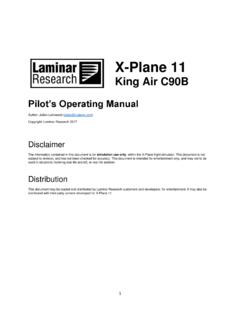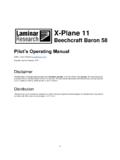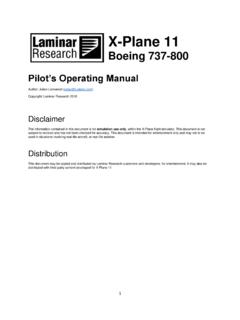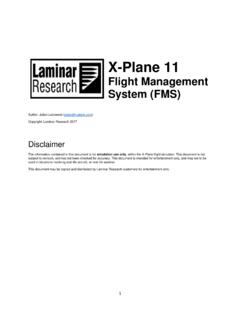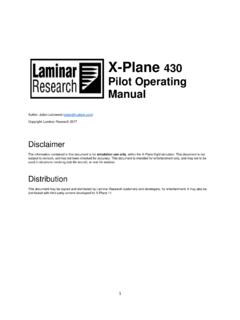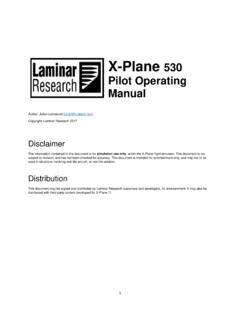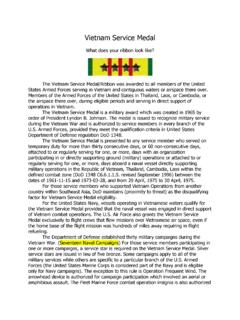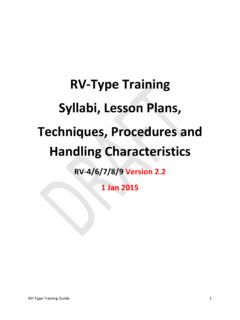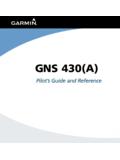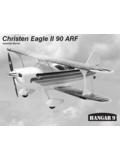Transcription of X-Plane 11
1 1 X-Plane 11 flight Management System (FMS) Author: Julian Lockwood Copyright: Laminar Research 2017 Disclaimer The information contained in this document is for simulation use only, within the X-Plane flight simulator. This document is not subject to revision, and has not been checked for accuracy. This document is intended for entertainment only, and may not to be used in situations involving real-life aircraft, or real-life aviation. This document may be copied and distributed by Laminar Research customers for entertainment only. 2 flight Management Systems .. 4 The X-Plane 11 flight Management System .. 5 The Pop-Up CDU .. 5 Invoking, moving, sizing, and closing the Pop-Up CDU .. 5 Components of the CDU .. 7 Programming a flight Plan .. 9 Initializing the CDU .. 9 Invoking the flight Plan Page .. 9 Programming the flight Plan Origin.
2 10 Programming the flight Plan Destination .. 10 Programming the flight Number .. 10 Executing the flight Plan segment .. 11 Programming the Departure .. 12 Selecting a Standard Instrument Departure (SID) .. 13 Selecting a Standard Instrument Departure (SID) Transition .. 13 Programming the route segment .. 14 Programming the Arrival .. 15 Selecting a Standard Instrument Arrival (STAR) .. 15 Selecting an Instrument Approach .. 15 Selecting an Approach Transition .. 16 Programming 17 Programming a FIX for Standard Instrument Departure (VTU6).. 18 Programming a FIX for Standard Instrument Arrival (BSR3).. 20 VNAV .. 21 VNAV Programming a Climb Transition Altitude .. 21 VNAV Programming Climb and Descent Speed Restrictions .. 22 VNAV - Programming a Cruise Altitude.. 23 VNAV - Programming a Target Speed .. 23 VNAV - Programming a Vertical Path Angle (VPA).
3 24 flight Plan Discontinuities .. 25 Inserting waypoints into an active flight Plan .. 27 Deleting waypoints from an active flight Plan .. 28 Direct To Waypoint .. 29 3 Resetting the flight Plan .. 30 Stepping through your route .. 31 Loading a (saved) flight Plan .. 32 Invoking the Route Menu Page .. 32 Saving a flight Plan .. 34 Invoking the Route Menu Page .. 34 Deleting a flight Plan .. 36 Autopilot Operations .. 37 Appendix .. 38 VENTURA SIX (VTU6) DEPARTURE plate .. 38 BIG SUR THREE (BSR3) ARRIVAL plate .. 39 4 flight Management Systems A flight Management System (FMS) is a centralized computer system used in airliners, and other high-performance aircraft, to manage many of the aircraft systems, including (but not limited to) the flight plan. Contemporary airliners rely on the FMS to automate a wide-variety of tasks, previously performed by navigators and flight engineers.
4 The presence of an FMS reduces the workload in the cockpit, allowing the aircraft to be operated by (usually) just two crew-members. To accomplish its assigned tasks, an FMS will interface with many aircraft systems, including engine, fuel, hydraulic, electrical, and navigation devices such as GPS, the on-board Inertial Navigation System, and the Nav radios. A flight Management System is an integration of several components, including: Control Display Unit (CDU) A small screen and touch-keypad that provides the interface through which the pilot operates the FMS. flight Management Computer The computer hardware and software needed to run the system. This is not visible to the pilot in the cockpit, and is usually located elsewhere in the aircraft. Multi-Function Display (MFD) One or more electronic displays (usually CRT or LCD) that provide the pilot with navigation progress, engine performance, and aircraft system information (depending on the mode selected).
5 5 The X-Plane 11 flight Management System The Laminar Research / X-Plane 11 FMS resembles a system built by Collins and found in regional airliners, and is similar in operation to the one used in Boeing aircraft, including the 737 (illustrated in this manual). Rival systems are built by Honeywell and Thales for use in Boeing and Airbus aircraft. Despite differences, both systems perform many of the same functions. Due to the immense complexity of a real-life flight Management System, the version modelled in X-Plane 11 is simplified, and does not support every capability. However, the functions necessary to program and execute a flight plan are present, including the use of published arrival and departure procedures (SIDs and STARs) and instrument approaches. The Pop-Up CDU For convenience, a pop-up CDU is provided in every X-Plane default aircraft that features a flight Management System.
6 This is a 2D panel that can be moved and sized per the needs of the pilot. For the purposes of this guide, we will present the pop-up CDU only. However, commands may also be input using the CDU panel built into the 3D cockpit. Invoking, moving, sizing, and closing the Pop-Up CDU Invoking the pop-up CDU To invoke the pop-up CDU panel, position and click the mouse-pointer anywhere inside the DISPLAY area of the CDU panel in the 3D cockpit. See highlighted area in image to left. 6 Moving the pop-up CDU To move the pop-up CDU panel to the desired location on your computer screen, first place the mouse-pointer anywhere on the outer-frame. The top-center is recommended, as shown here by the white arrow. Now click and drag the pop-up CDU panel to the desired location on your computer screen. Re-sizing the pop-up CDU Place the mouse-pointer at the top-center of the CDU frame.
7 Two click-spots will appear. The click-spot in the UPPER-RIGHT of the CDU frame invokes Window mode. In this mode, the CDU panel can be re-sized by dragging the window frame - in the same manner as any other window supported by your operating system. Closing the pop-up CDU Place the mouse-pointer at the top-center of the CDU frame. Two click-spots will appear. The (red) click-spot in the UPPER-LEFT of the CDU frame closes the pop-up. 7 Components of the CDU The Control Display Unit (CDU) provides the interface between the pilot and the flight Management Computer (FMC). It consists of a display panel, and a series of keys that are grouped together according to their function. Display This panel provides a simple output display to the pilot, allowing him to program the unit, make commands, and select available options. Scratch Pad This area of the CDU Display is used for Key Pad input.
8 Inputs made by the pilot are initially displayed here, before a Line Select Key is chosen, to move this text to the appropriate line of the CDU Display (above the scratch pad). Line Select Keys These keys are used to make selections from the options provided alongside them, in the CDU Display. The keys on the left-side of the unit align with the options on the left-side of the display, and vice-versa. Key Pad Used to input text into the scratch pad area on the CDU display. 8 Page Keys These keys are used to select the page presented in the Display Area. The primary functions of the CDU are grouped by Page . This simplifies the presentation, and provides a logical work-flow to the pilot. Exec Key This key is used to activate a flight plan, or a segment of a flight plan, or to commit changes to an active flight plan. When the light bar (above the key) is illuminated, this key must be pressed to commit changes that have been input by the pilot, and are currently pending.
9 Clear Key This key clears text currently displayed in the Scratch Pad . 9 Programming a flight Plan In this section of the guide, the pilot will program the CDU with a manually input flight plan. The flight plan used in this example originates at KLAX (Los Angeles International), and terminates at KSFO (San Francisco International). We will depart runway 25R at KLAX, and use the VTU5 Standard Instrument Departure (SID), with the RZS Transition waypoint. The route-segment of the flight plan will be via the BSR VOR/DME. We will arrive runway 28R at KSFO, and use the BSR3 Standard Instrument Arrival (STAR). The full route is as follows: KLAX, VTU5, RZS, BSR, BSR3, KSFO Important flight plan waypoints and procedures change over time. The sample flight plan used here may no longer be current, and some of these waypoints may not be available for selection during your flight .
10 Therefore it is not recommended you attempt to duplicate these steps in X-Plane - but instead use the examples below as guidelines for inputting and managing your own flight plan. Loading a previously-saved flight -plan is discussed later in this guide, in the section Loading a (saved) flight Plan. Initializing the CDU Boeing CDUs feature an INIT REF or POS INIT key that is used to initialize the flight Management System at the start of a new flight . This initialization process includes the alignment of the Inertial Navigation System (INS), the computation of V-Speeds, and several other factors that relate to the aircraft loading and performance. These features are highly specific to the particular type of aircraft flown, and therefore not available in the X-Plane 11 FMS, which can be used with every aircraft. Therefore, the pilot begins programming the CDU at the flight Plan Page.
